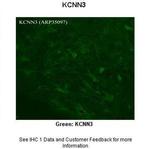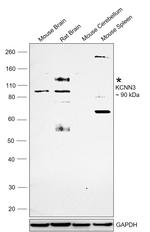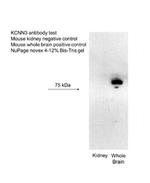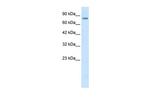Search Thermo Fisher Scientific
FIGURE: 1 / 5
KCNN3 Antibody (PA5-41014) in IHC (P)





Product Details
PA5-41014
Species Reactivity
Host/Isotype
Class
Type
Immunogen
Conjugate
Form
Concentration
Purification
Storage buffer
Contains
Storage conditions
Shipping conditions
RRID
Product Specific Information
Peptide sequence: ITELNDRSED LEKQIGSLES KLEHLTASFN SLPLLIADTL RQQQQQLLSA
Sequence homology: Cow: 100%; Dog: 100%; Guinea Pig: 100%; Horse: 93%; Human: 100%; Mouse: 100%; Rabbit: 100%; Rat: 100%
Target Information
Action potentials in vertebrate neurons are followed by an afterhyperpolarization (AHP) that may persist for several seconds and may have profound consequences for the firing pattern of the neuron. Each component of the AHP is kinetically distinct and is mediated by different calcium-activated potassium channels. KCNN3, a member of the KCNN family of potassium channel genes, encodes a protein that is activated before membrane hyperpolarization and is thought to regulate neuronal excitability by contributing to the slow component of synaptic AHP. The encoded protein is an integral membrane protein that forms a voltage-independent calcium-activated channel with three other calmodulin-binding subunits.
For Research Use Only. Not for use in diagnostic procedures. Not for resale without express authorization.
References (0)
Bioinformatics
Protein Aliases: KCa2.3; potassium channel, calcium activated intermediate/small conductance subfamily N alpha, member 3; potassium intermediate/small conductance calcium-activated channel, subfamily N, member 3; SK3; SKCa 3; small conductance calcium-activated potassium channel 3; Small conductance calcium-activated potassium channel protein 3
Gene Aliases: hSK3; K3; KCa2.3; KCNN3; SK3; SKCA3
UniProt ID: (Human) Q9UGI6, (Mouse) P58391
Entrez Gene ID: (Human) 3782, (Mouse) 140493

Performance Guarantee
If an Invitrogen™ antibody doesn't perform as described on our website or datasheet,we'll replace the product at no cost to you, or provide you with a credit for a future purchase.*
Learn more
We're here to help
Get expert recommendations for common problems or connect directly with an on staff expert for technical assistance related to applications, equipment and general product use.
Contact tech support
